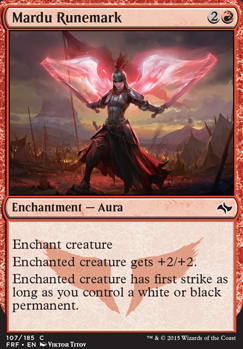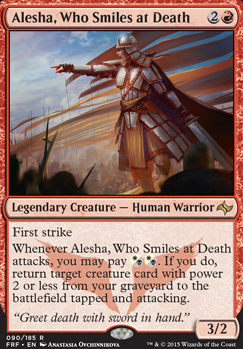Thought Process
Some Baseline Strategy
This version of Alesha, Who Smiles at Death seeks to stock the graveyard with a host of creatures that provide answers to a variety of board states and problematic permanents. The three key points to address to achieve this goal are: 1) Getting the creatures into your graveyard, 2) Having multiple ways to reliably recur them, and 3) Ensuring they can be returned to the graveyard for repeated use. For the majority of the game, you will be focused on assembling your value engines while attempting to fly under the radar. You don't want to build an overwhelming board state until you are ready to win the game, because that is the moment you put a target on your back. Piloting the deck should be about timing and restraint; you want to have enough resources on the battlefield and in the graveyard to allow you to address things that threaten you or your game plan, but you don't want to draw attention to yourself or be set back too far if someone deems it necessary to disrupt your progress.
Composition Breakdown
When critiquing the deck, please consider the framework described below. These numbers are not absolute, but they are tested theories that have proven successful in broadly applicable scenarios. Some components could require adjustment for this specific list.
I am shooting for the following general deck construction guidelines for the supporting framework of the deck:
- 37-38 lands
- 10 ramp
- 10 draw
- 4-5 board wipes
- 10 targeted removal (the standard is typically 5, but I aim for 10 here since we are playing toolbox)
And the following general deck construction guidelines for the meat of the deck (to push toward winning):
- 25 standalone (generally good, solid cards that don't rely heavily on other cards [but maybe Alesha] to function)
- 10-12 enhancers (cards that don't do much by themselves, but amplify or synergize well with the strategy)
- 7-8 enablers (cards whose primary function is to cover weaknesses in the deck or protect the strategy)
If you select "Custom Categories" in the drop-down list in the top left corner of the deck list area, you will be able to see how I have organized the cards in the deck into the various categories mentioned above.
Lands
Because this deck is not rushing to win, we do not need to sculpt the mana base to allow us to consistently drop threats early or on time. This affords us the luxury of running perhaps a few more lands that serve a utility role. We don't want to run too many utility lands, since that would prevent us from having the right colors of mana to cast our spells, but a decent number of utility land options will make the cut because they align well with our game plan. For instance, Volrath's Stronghold is a prime utility land for this deck since it adds redundancy to our recursion suite, but can also tap for mana.
I do think that we may want to include more than three of each basic, so as to give us more to pull out of the deck, but I haven't tested the deck to know how often we run out of basics for our ramp effects. I think after enough testing, I'll be able to make that call with more confidence, and make adjustments accordingly.
Ramp
Not having access to green means that our ramp options will be more limited, but there are a number of good choices that align with our deck's core principles. Creatures that with power 2 or less that can be recurred for repeatable ramp are especially prime options in Alesha, so cards like Solemn Simulacrum, Burnished Hart, Kor Cartographer, and Knight of the White Orchid have a lot of potential.
On top of reusable creature ramp, we will include some standard mana rocks in non-green three-color combinations, such as the signets, Sol Ring, and Chromatic Lantern. Chromatic Lantern is a mana rock I particularly like in decks with three or more colors, because it eases our color-fixing woes and allows our utility lands to be flexible mana producers when we need them to be. I also think that Sword of the Animist is quite good in non-green decks with creatures that attack with relative frequency. Rampant Growth every turn seems pretty solid to me.
Even though the creature-based ramp provides us with the highest potential for value, I generally try to keep core components of any deck (draw, ramp, etc.) from being too one-dimensional. This keeps us from getting shut-down if one of these options is made infeasible by the board state (for example, a Torpor Orb would make our creature-based ramp useless).
Draw
Similarly to ramp, it is ideal when we can find creatures with power 2 or less that we can use as repeatable draw engines. Some creatures that are prime options along this vein are Mentor of the Meek, which provides sustained card advantage over the long term, and creatures like Disciple of Bolas and Vulturous Aven, which provide card draw capability upon entering the battlefield. Some card-drawing creatures that work double-duty are Solemn Simulacrum, which can ramp us and draw us cards upon death, and Mindless Automaton, which can allow us to pitch creature cards sitting in our hand in order to allow us to recur them with Alesha.
Despite the sheer value of creature-based draw in this deck, as I stated in the ramp section, I think it is a good idea to have at least a little bit of diversity in each key area of deck-functioning. As such, I have included Phyrexian Arena, an excellent long-term value draw engine that puts in a ton of work over the course of a game, as well as Vampiric Rites and Skullclamp, which aren't creatures but still align well with our deck's go-to strategies.
Value
Numerous cards have been considered due to their nature of being tangent to certain incidental sub-themes within the deck. Due to the large number of ETB (enter-the-battlefield) effects, Panharmonicon has some promise for amping up our value engines. Since we naturally want to sacrifice our creatures in order to continuously recur them, Blood Artist and friends (i.e. Falkenrath Noble, Zulaport Cutthroat, etc.) also seem promising.
Because of our inherent capacity - as a reanimator deck - to get multiple uses from our creatures, we have the option to trim back a little bit on essential categories of the deck, such as ramp, draw, or spot removal. It's risky to trim back too much on these areas, given that this will reduce our chances of drawing into them when we need them, so it won't even matter if we can reuse them. I would say that this would only be a good idea if we cannot find other areas of the deck to trim back.
Removal
Having access to both black and white means that we have access to some of the most flexible targeted removal and board wipes there are in EDH. Of course, it is still true that when we can find these effects stapled to creatures with power 2 or less, it is tempting to run them for repeatable use. Naturally, it follows that we are running cards like Nekrataal, Ravenous Chupacabra, Duplicant, and Duergar Hedge-Mage. Creatures like Fiend Hunter and Leonin Relic Warden also synergize with a free sacrifice outlet in an interesting way. Due to how their abilities are worded in two separate clauses (much like Oblivion Ring), if we sacrifice them while their ETB ability is still on the stack, their leave-the-battlefield ability will resolve first, resulting in a somewhat roundabout way of permanently exiling their targets.
I think it also wise to run a couple of minimally-conditional, instant-speed removal spells, so Anguished Unmaking and Utter End seem like solid inclusions.
Beyond targeted removal, we have to be sure to include a handful of board wipes to have a hard-reset when we need it. As a deck that dabbles with the graveyard, we can expect to be impacted less on average by traditional board wipes. Because of our desire to keep our creatures in our graveyard, we generally favor wraths that destroy creatures, as opposed to things like Hallowed Burial or Descend upon the Sinful, although we do have enough sacrifice outlets that we would be comfortable running some of those effects to more permanently deal with opponents' creatures while still being able to send ours to the graveyard. There are also numerous wraths that are selective for power of creatures, like Retribution of the Meek and Fell the Mighty. We can use these to our advantage, since the vast majority of our creatures will typically survive these spells.
Tragic Arrogance and Merciless Eviction are some of my favorites, because they are flexible enough to give you a fair amount of control over the outcome. False Prophet is very interesting because it's a repeatable mass-exile effect that provides a panic button that you can manipulate with Alesha's reanimation and a sacrifice outlet. The downside is that an opponent can use their own removal on it if you play it before you are prepared to use it yourself. Furthermore, having a repeatable mass-exile effect might lead to slow and grueling games that opponents will begin to dread, so we have to consider the fun-factor, as well, when deliberating over this choice. We want to build a powerful, synergistic, and interesting deck, but we want people to enjoy playing against it.
Redundancy
It is important to have multiple cards with desired effects in a deck to increase consistency and avoid sputtering out, but it is also possible to have too many redundancies of certain effects. As such, we must take care to strike a delicate balance between having too few or too many of these effects. Certain areas in the deck, such as protection and evasion-granting cards can be trimmed back, as having too many of these situational cards can lead to a detrimental frequency of dead draws. That is not to say that these cards are not important, but that they are better in moderation.
Recursion
Recursion effects, in this context, are spells and abilities that either return creatures directly from the graveyard to the battlefield, or return them to our hand so we can re-cast them later. Alesha, Who Smiles at Death has her own built-in recursion effect, so it may be tempting to rely heavily upon it, but it is essential to have a back-up plan if we cannot use her for any reason. There are plenty of cards that synergize well with our game plan and fill these roles, be it creatures with power 2 or less that recur things, like Karmic Guide or Ravos, Soultender, or creatures that recur small creatures, like Sun Titan or Reveillark.



